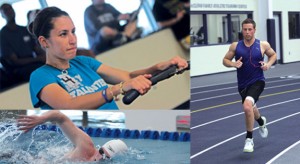Senior Antoine Connors propels through the water in the Athletics and Events Center pool — a few feet ahead of four other competitors — and hits the wall as the time on the judge’s stopwatch hits 10 minutes on the dot. But as Connors exits the pool knowing he has finished the event in first place, he still has two other events that will test his physical and mental endurance.

Connors was one of nine participants in the Ithaca College Indoor Triathlon held Sunday in the Athletics and Events Center. Each participant paid $7 to compete in three events in the pool and the arena — swimming, rowing and running — as part of their first triathlon.
Connors said he was looking for an event that would motivate him to remain fit after his career in college athletics ended.
“I recently finished my last season on the varsity swimming team, and I figured I should try to do something to stay in shape,” Connors said. “I’ve been very competitive since I was six or seven, and it’s really hard to drive that out of me.”
The event was the final project for Sport Event and Facility Management, a class in the sports management and media department. Graduate student Lyndsay Bisaccio said the class wanted to put on an event that had not been done before, but was also practical.
“We were looking to do a race of some kind and wanted to try something a little bit different than a standard 5K race that a lot of groups have looked to put on in the past,” she said.
While triathlons typically consist of an open-water swim, a bike ride and a run, indoor triathlons are able to reduce costs and risk by holding all three legs within a single facility.
“When you’re inside, you don’t have to worry about mapping out a course or any sort of run-in with cars for the bike or running, and not having to deal with open water for swimming is certainly safer,” Bisaccio said.
Athletes in a full outdoor triathlon are usually required to swim, bike and run a set distance within the fastest time in each event, while distances range from 5 kilometers of running and 2.4 miles of swimming, according to USA Triathlon.
The class’s indoor triathlon, however, was a race to complete the most distance within 10 minutes. The distances covered during each event were entered into a points formula that Craig Paiement, assistant professor in the Department of Sports Management and Media, created with his class. Points earned on the rowing machines were worth 40 percent of the final score, the running was worth 35 percent and the swimming was valued at 25 percent.
Paiement organized triathlons and road races when he was executive director of Suncoast Sports, Inc., in Orlando, Fla., before becoming chair of the college’s graduate program in sports management and media. He said the scoring system must be altered for an indoor triathlon because space is limited for competitors.
“Instead of setting a distance and having it measured by time, you’re setting a time and having it measure by distance,” Paiement said. “For the competitors, it changes the competition because you don’t know where you stand. In a traditional triathlon, if you’re in first, you’re in first.”
The low registration cost made the triathlon at the college more easily accessible to people on campus that were interested in taking part. The annual Iron Man Triathlon in New York City has charged competitors more than $1,000, and the local Cayuga Lake Triathlon costs $90 to participate in, Paiement said.
Connors was worried the scoring system would not play to his strengths in the pool.
“I was originally concerned because it was total distance, and considering I’m a swimmer, my greatest strength would account for the least distance,” he said. “I was thinking that it was going to be really unfair, but they seemed to find a system that worked out really well.”
Graduate student John Ostler finished second overall in the field of nine competitors. His toughest challenge was competing in the swimming event.
“I run on my own recreationally, but otherwise I haven’t been swimming since last summer,” he said. “It was tough — 10 minutes in the pool was quite a long time.”
Paiement thought the swimming event in the triathlon was the most different of the events because it was less intense. The open- water swim is often the most daunting event of the three because competitors are shoulder-to-shoulder with one another until they cross the finish line.
“People that do their first triathlon in a regular open-water triathlon — that swim is the most terrifying thing because you get beat up pretty well,” Paiement said. “I was in a race where the guy who won got his front teeth kicked out 20 yards into the swim. The guy won the race with his two front teeth in the bottom of Tampa Bay.”
Connors built up an insurmountable lead in the swimming portion and was able to withstand a challenge from Ostler to win the event. Connors said all the participants were friendly with one another despite the intensity during each event.
Bisaccio hoped the class would get more competitors from on-campus organizations such as the Ithaca College Triathlon Club and the Physical Activity, Leisure and Safety Triathlon class.
“We struggled with time constraints of being in a semester system and having to put it on before the end,” she said. “More specific targeting towards specific groups could have helped.”
Graduate student Nick Chavez, who was in charge of putting on the triathlon, thinks the event will grow in popularity because it’s a good way for athletes to be introduced to more intense triathlons.
“Hopefully future classes might adopt this and make it into an annual tradition here at Ithaca,” he said. “Seventy percent of the campus uses the Fitness Center daily, so the campus has the right attitude towards it, and it could really take off in the coming years.”







